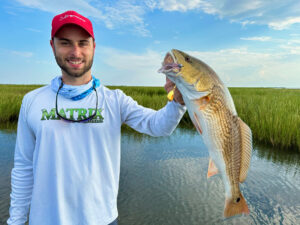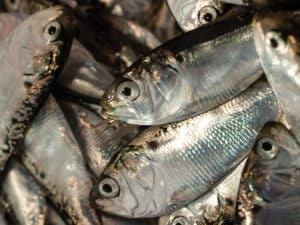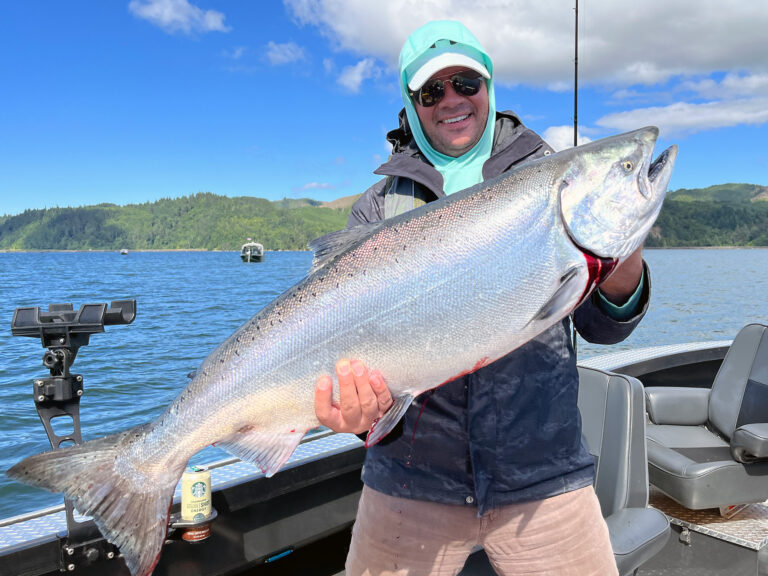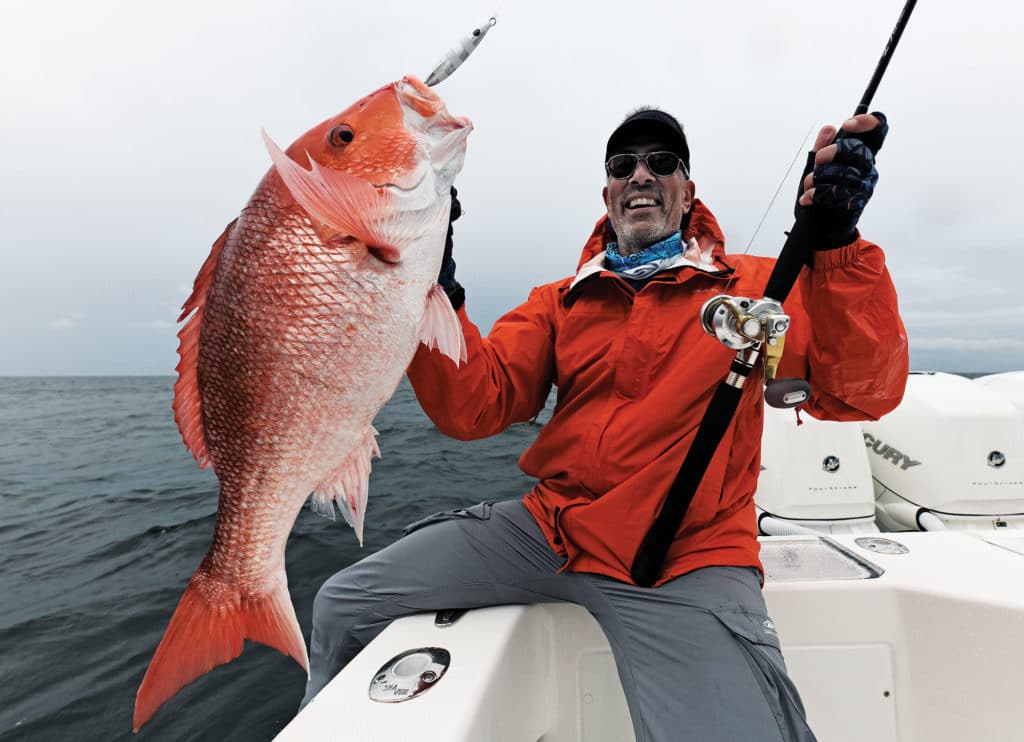
Frustration was setting in as, for another drift, we slowly navigated over the structure-cluttered bottom and continued to see the Simrad fish finder light up with elongated marks indicative of large fish. We had tried dropping live menhaden on mono and fluorocarbon leaders, weighted with various-size egg sinkers, without success.
Then I suggested we try vertical jigging. We dropped long slender jigs, retrieving them at high speed. Still, no takers. So, in a “why not?” moment, I located a very different sort of jig, shorter and more oval-shaped—one I’d not used in a while. I dropped down a 150-gram (5-ounce) Shimano Butterfly Flat Fall slow-pitch jig to the 70-foot mark (as indicated by my color-coded braided line). I slowly raised the rod tip of my jigging rod, then dropped the tip to let the jig flutter down as I turned the reel handle one full turn and repeated the same slow-pitch retrieve again.
After another slow lift of the rod, as I let the jig fall, my rod—a Shimano Trevalla S—was almost ripped from my hands in a monstrous strike. Drag from the Tranx 500 levelwind screamed out, and the purpose-designed parabolic rod bent in an extreme bow. After a 25-minute tug of war, a healthy amberjack showed at the surface.
After that, other anglers in the boat enlisted the same tactic. With slow-pitch jigging, we caught more fish, including more AJs, king mackerel and even a cobia—after nothing else would work for us.
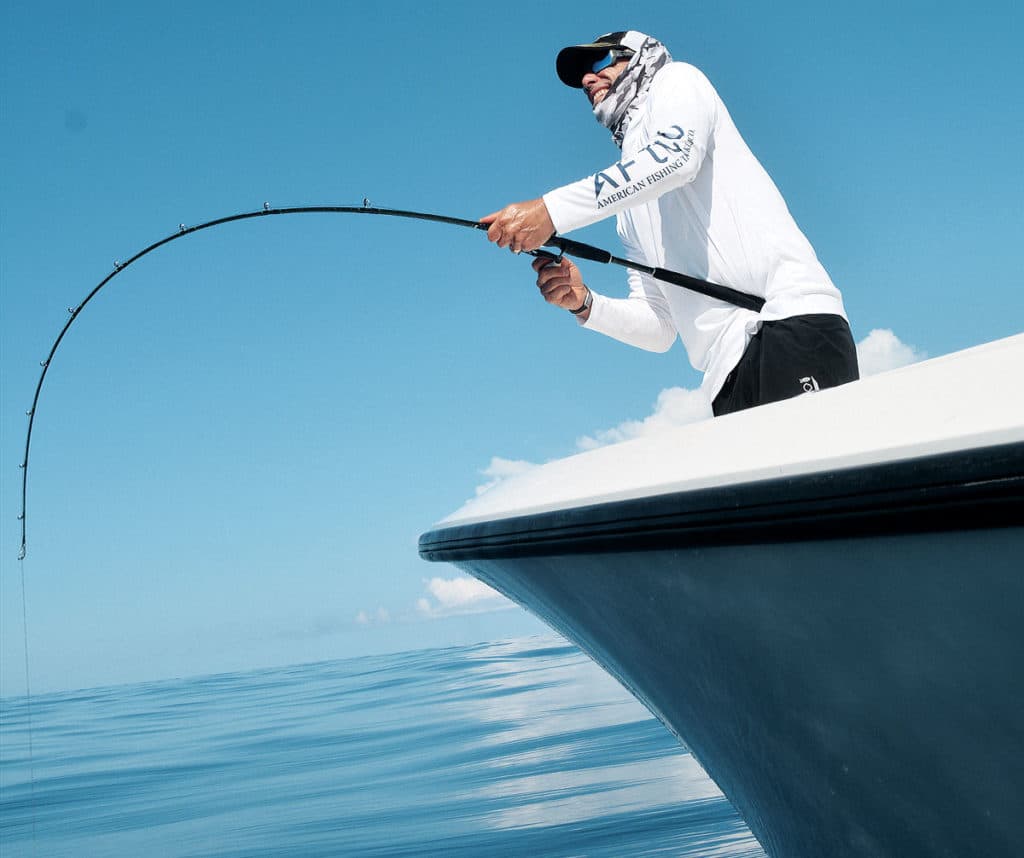
Slow-Pitch Demystified
In fact, slow-pitch jigging is an extraordinarily effective way to catch many species even under challenging conditions. If you’re targeting multiple species, this jigging technique can be much more effective than the more traditional high-speed approach.
There are actually two styles of slow‑pitch jigging: short pitch and long pitch. The difference lies in how you move the rod tip. Short pitch is the less aggressive style in which the angler moves the rod—and therefore, the jig—only a short distance at a time, while long pitch is a more aggressive style that moves the rod and jig a somewhat greater distance through the water column on each stroke.
Melvin Heng from Shimano Singapore points to the techniques used by Southeast Asian anglers. He says they favor the more aggressive long-pitch style. On the other hand, most Japanese jiggers fish with the short-pitch or abunai style, which means “watch out.”
The short-pitch style of slow-jigging developed in Japan, largely thanks to deepwater angler Norihiro Sato, who faced the sort of challenges I described earlier, when trying to catch inactive, nonfeeding fish. Sato has since revolutionized a whole new way of fishing using light rods, small but powerful reels, and jigs that are broad, flat and short, which flutter irresistibly as they drop. The action mimics that of a squid, sardine, bunker or other prey species that is wounded and trying in vain to swim away.
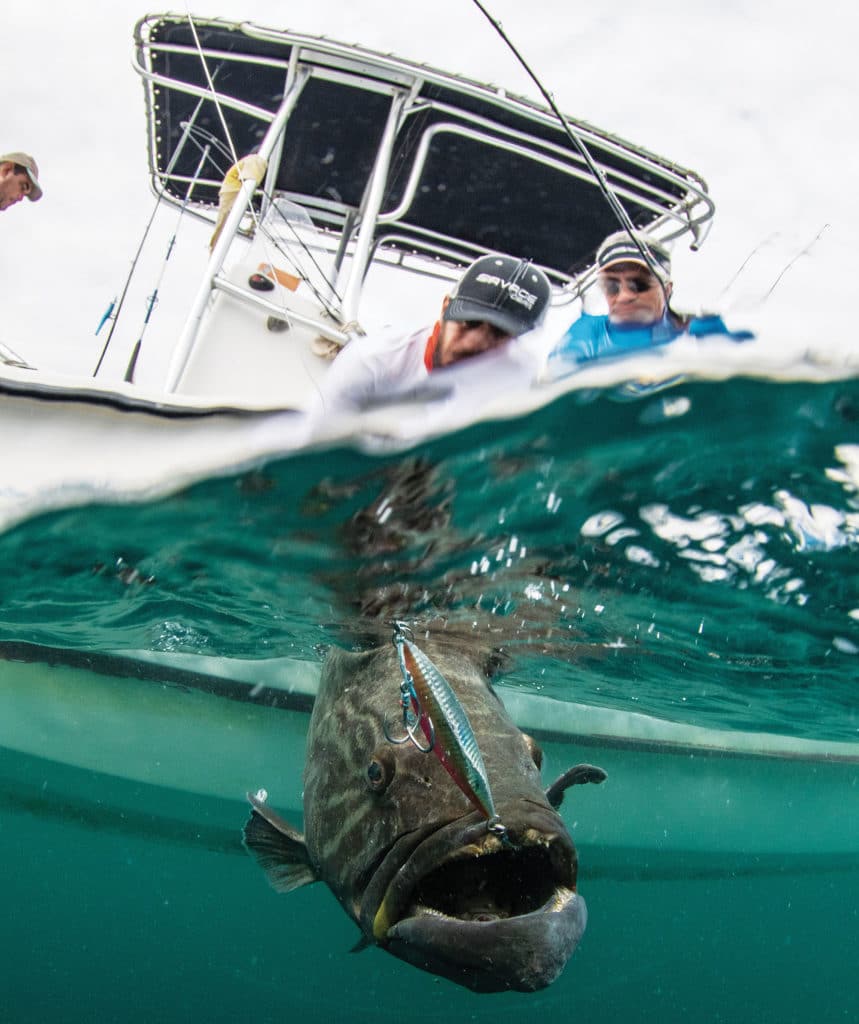
The technique that started in Asia six years ago was also referred to as micro- or slow-jigging. It has been refined by a number of American anglers for application in U.S. waters. Florida-based enthusiasts Benny Ortiz and Rick DePaiva are two fishermen who have spent considerable time and effort advancing the techniques and technology of this method. They have fished all types of slow-pitch jigs, and countless types of rods, reels and lines.
John Bishop, who owns and operates a fishing-supply store in Tidewater, Virginia, is another fisherman with years of experience in tackle trends and what works for anglers, especially in the area of slow-pitch jigging. The collective experience of these experts provided me with a wealth of timely and valuable insight for any angler out to get into slow-pitch jigging, as well as experienced anglers looking to improve the tactic.
In general, compared with many other styles of fishing, slow-pitching is extraordinarily specialized, and tackle makes all the difference in catch success. For Ortiz, that means gear that is “as light and strong as possible.” Ortiz, like DePaiva, has caught fish slow-pitching in depths of water anywhere from 50 to 1,500 feet. Both men agree that slow-pitch jigging works best in depths over 150 feet. Ortiz has caught 73 different species of fish using this method.
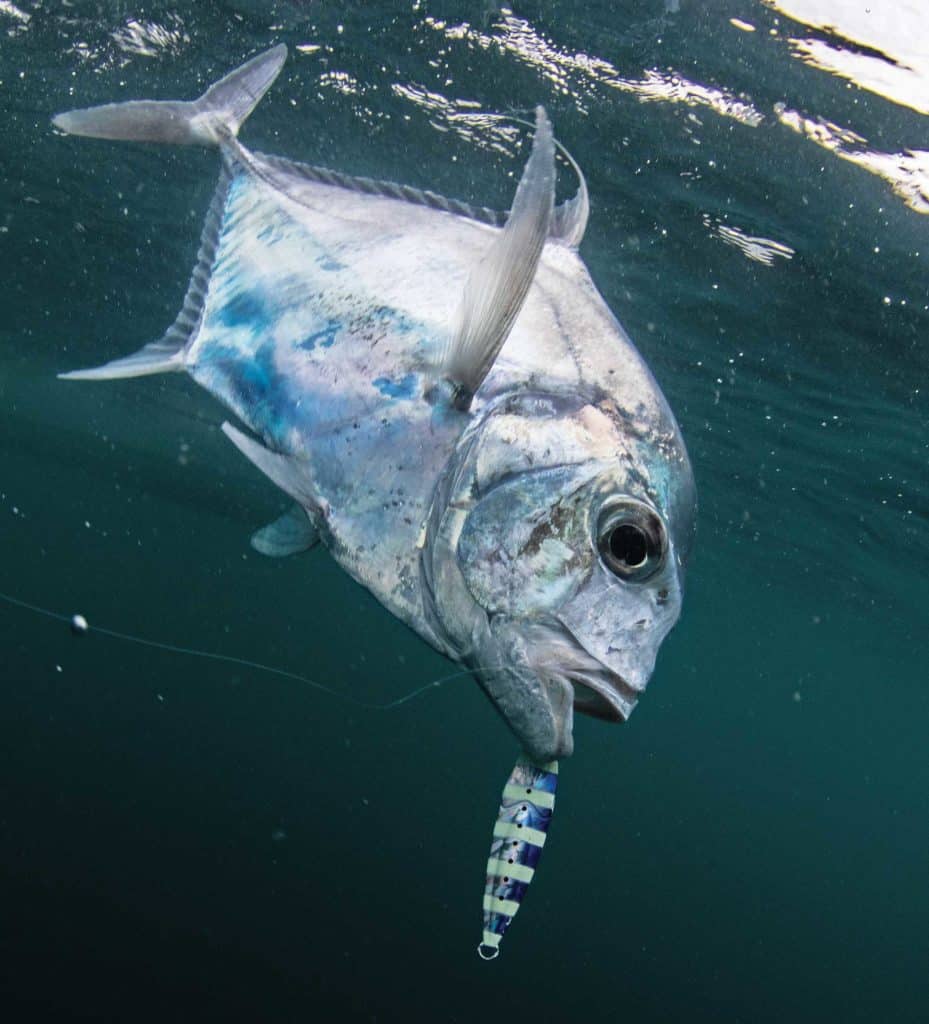
Make It Dance
Rods for slow-pitch fishing are designed to move jigs through the water in a certain way. DePaiva says what makes the specialized slow rod so important is that it’s actually “puppeteering” the jig, making it dance as if from a marionette’s sticks. Ortiz prefers using rods ranging from 6 feet, 3 inches to 6 feet, 10 inches. Some brands of specially designed rods used by slow-jig experts: the Levitate and Gravitate series by Temple Reef; the Trevala S, Ocea, SpeedMaster and JigWrex by Shimano; and the Valiant series by Accurate. Okuma has also introduced a slow-pitch rod.
Temple Reef rods differ in their guide alignment from most rods in that they use microguides placed in a spiral configuration; in Ortiz’s view, this “levels out the rod,” referring to load distribution, when fighting large fish. That design also, by his observation, “gets the line off the tip” when jigging. These rods tend to be high-carbon material with lots of recoil, which is key to imparting action in the jig. Ortiz and DePaiva both believe that fishing deeper water requires higher-recoil blanks, because it’s that recoil that imparts the sharp upward motion in the jig, so the angler can let it fall freely, with the greatest action.
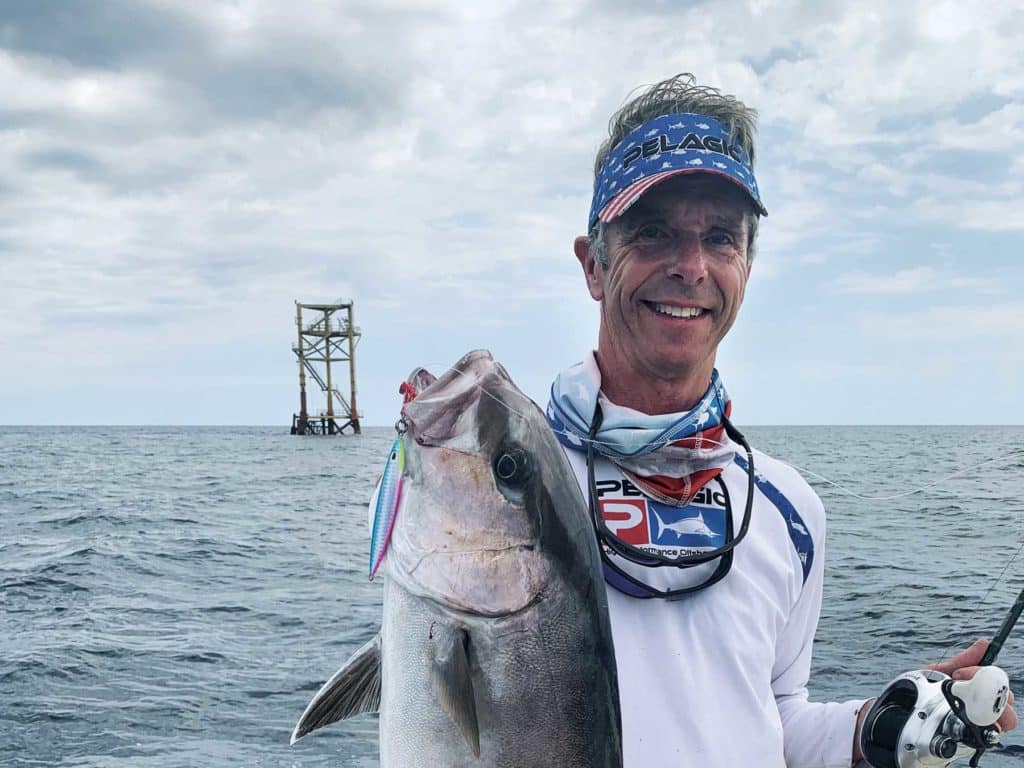
Crank ‘Em In
As a tackle-shop owner, Bishop finds that while a few slow-pitch enthusiasts do swear by spinning reels, most prefer small fast-retrieve conventional reels. Ortiz agrees with the fast-retrieve ratio but says what matters most is the rate of line retrieval. He believes that the retrieval rate should be between 38 and 45 inches per crank. For that reason, it’s important to have a long handle with conventional reels, which also allows the angler to gain better leverage on a fish during the fight. Ortiz likes the reel’s knob to be 3¾ to 4 inches from the center of the handle.
Ortiz emphasizes that once the fish is off the bottom, the rod is less important than the reel. Slow-pitch experts stress understanding the limitations of the tackle, notably that slow-pitch rods aren’t really designed to lift fish. When Ortiz fights fish, he keeps the rod between horizontal and 45 degrees down, relying on the reel to crank in the fish. He calls this the flat technique. When fighting fish, keep the slow-pitch rod’s angle at or below parallel to the water, preferably around 45 degrees below parallel, and use the reel to bring the fish to the surface.
However, just after hooking a big fish—which Ortiz believes is “the most violent time in the contest”—he does use the rod to pressure a fish and keep it away from bottom structure. Ortiz stresses that it’s critical to avoid lifting the rod much above parallel. High-sticking, by raising the rod higher, can result in catastrophic rod failure. He emphasizes that an angler gains only 12 or so inches by lifting the rod, but up to 45 inches with each turn of the reel handle.
Lever-drag reels are preferred over star drags with hardcore slow-pitchers because they’re more precise in applying drag. Ortiz emphasizes that the most critical step is to win the first five to 10 seconds of the fight, and to keep cranking even if the fish is pulling drag.
Among small, powerful reels popular for this technique are Accurate’s Boss Dauntless and Valiant series, Shimano’s Talica 12 and Tranx 400 and 500, the MXL 6/4 G2 and SX 6/4 G2 series by Avet, Penn’s Torque 15LD2S, and Okuma’s Andros.
Rigging Up
Using light line for slow-pitch jigging is critical when you’re trying to get the jig down into deeper water. Braided line’s minimal stretch and thin diameter make it the universal choice of any serious jigger.
And the serious jiggers with whom I spoke all prefer braid testing 30 pounds or even lighter. Most of the slow-pitch small reels cited above can generate drag of 20 to 30 pounds. Ortiz points out that the breaking strength for 30-pound braid typically comes in around 43 to 46 pounds, so, assuming optimal knots, too much drag breaking the line shouldn’t be a worry. When Ortiz and DePaiva want to drop to even-deeper waters, they go with 14- or 20-pound line.
For leader, Ortiz uses 50-pound fluoro; he cites its stiffness, better abrasion resistance and knot strength. DePaiva goes lighter, with 30- to 40-pound fluoro. The length of leader recommended by Ortiz is specific and precise: four arm lengths. He connects the business end of that leader to a ball-bearing swivel, adding a split ring to the bottom of the swivel. To that split ring, Ortiz connects a solid ring and the jig separately. Finally, he adds his assist hooks to the solid ring.
“This allows you to open the split rings and remove the jig without having to take the hooks on and off every time,” he says. “And it keeps a direct, in-line connection from your leader to the top hooks, with the jig swinging and independent of both.”
Not surprisingly, he strongly recommends that any jig enthusiast invest in a good pair of split-ring pliers.
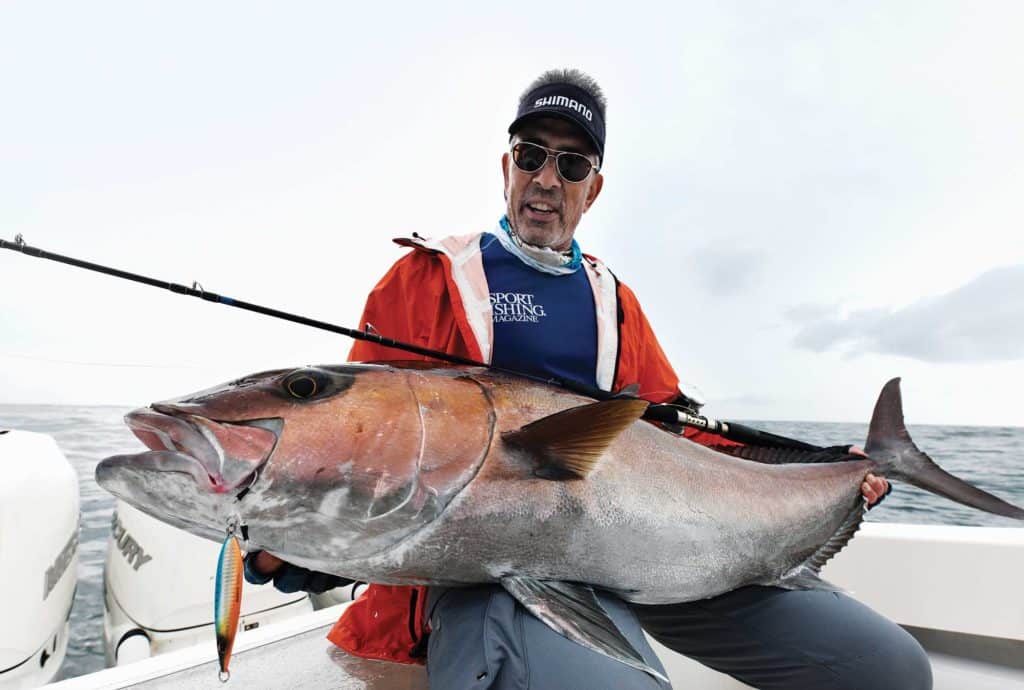
Quick Drop and Slow Pitch
Serious slow-pitch jig fishermen tend to accumulate impressive collections of jigs, but they do have their favorites. Ortiz (nickname: “jig nut”) says that he has so many jigs—to cover nearly all possible conditions and depths—that he could “chum with them.”
Current can have a big effect on getting a jig to the bottom, and how well the angler stays in contact with the jig and effectively imparts action. DePaiva often uses a sea anchor to slow his boat’s drift so he can stay on top of his jig. Ortiz relies heavily on Sea Falcon, Seafloor and NLO jigs.
There are many different shapes of jigs, and the shape will determine the type of flutter and fall. The different types of fall—hence, action—identified by Ortiz are what he terms the falling leaf, flutter and arc. While shape is significant, keep in mind the importance of using a jig that gets to the bottom—or wherever fish are holding—quickly.
DePaiva prefers silver, chrome and all luminescent colors. Ortiz says that even though color might not be critical, he tends to use gold, silver and any jig that glows. He suggests carrying a fluorescent flashlight to charge the luminescence in the jig. Ortiz is particularly keen on the orange with fluorescent stripes. “Fish eat that one a lot,” he says simply.
Ortiz favors Gamakatsu 510 assist hooks without barbs that will not nick the leader and an Owner Dual Dancing Stinger Guardian hook rig. DePaiva uses Mustad’s Slow Pitch Jigging Assist hooks with green beads. VMC’s new 7117AH assist hooks sport an unusual design with a “technical locking curve.”
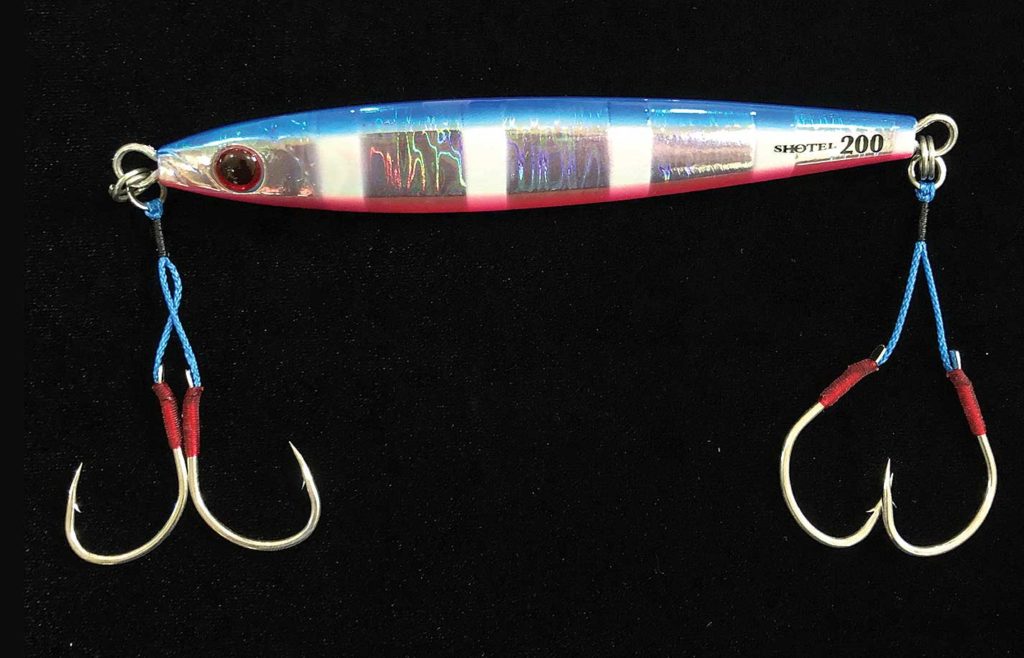
Jiggers’ Tips
Ortiz offers detailed insight into the technique he finds most effective. Place the rod butt under your forearm and use that as the leverage point to lift the rod. Lift enough to load the rod, then stop the lift and let the rod’s recoil spring up the tip. Drop the rod tip to allow the jig to flutter down. Through practice, an angler should develop a sense for the action of the rod and the jig. Having the rod under your forearm gives you the greatest range of motion in working the jig, Ortiz says.
He focuses on the fall of the jig because “that is where you will most likely get bit.” Ortiz stresses not winding down to the jig as you drop the rod tip, but rather to follow the fall with the rod tip, allowing slack line to pay out and then tighten as the jig finishes its fall. It’s the slack line that allows the jig its action on the drop.
Read Next: Drift-Fish Reefs Using Ballyhoo on Bucktail Jigs
DePaiva emphasizes keeping the jig within 15 to 30 feet of the bottom because you’ll catch most fish in this zone. Ortiz echoes that, noting that he catches most of his fish—including blackfin tuna and even sailfish—in the bottom third of the water column. He constantly checks for the bottom with his jig so he knows its location in the water column. By counting the number of turns of the reel handle and knowing how much line is retrieved per handle turn, he can know exactly where his jig is in relation to the bottom.
Slow-pitch jigging is addictive in large part because you never know what you’re going to catch. Figuring out the right gear and how to deploy it is a challenge worth pursuing; this technique can and often will catch fish when nothing else seems to work.
Some Sources of Slow-Pitch-Jigging Tackle
When it comes to slow-pitch jigging, it can be tough to find exactly what an angler needs to jig successfully. A number of Japanese tackle suppliers sell this specialized gear, but dealing with language barriers, currency conversion, shipping costs and import duties makes these transactions difficult. I can attest from experience that it’s much easier to do business with tackle suppliers located in the United States, and in recent years, these tackle shops have made available the same cutting-edge jigging tackle previously available only in Japan. Also, domestic tackle manufacturers now generally offer rods and reels designed for slow-pitch jigging. Some of the tackle sources cited by jig-fishing experts include:
Bishops Fishing Supply
Yorktown, Virginia
bishopfishingsupply.net
757-591-9300
Capt. Harry’s Fishing Supply
Miami, Florida
captharry.com
800-327-4088; 305-374-4661
Ocean Tackle International
Egg Harbor Township, New Jersey
oceantackle.net
877-803-6231
Reel Seat Inc.
Brielle, New Jersey
reelseat.com
732-223-5353
Saltywater Tackle
Sayreville, New Jersey
saltywatertackle.com
732-307-2580
Tackle Direct
Egg Harbor Township, New Jersey
tackledirect.com
888-354-7335; 609-788-3819
Tackle World (formerly Jigging World)
Rochelle Park, New Jersey
tackleworld.com
201-587-0011
About the Author
Rob Wittman grew up working on charter boats in the mid-Atlantic. His passion for fishing informs his efforts these days as a U.S. Congressman representing Virginia’s first Congressional district, which includes much of coastal Virginia.



